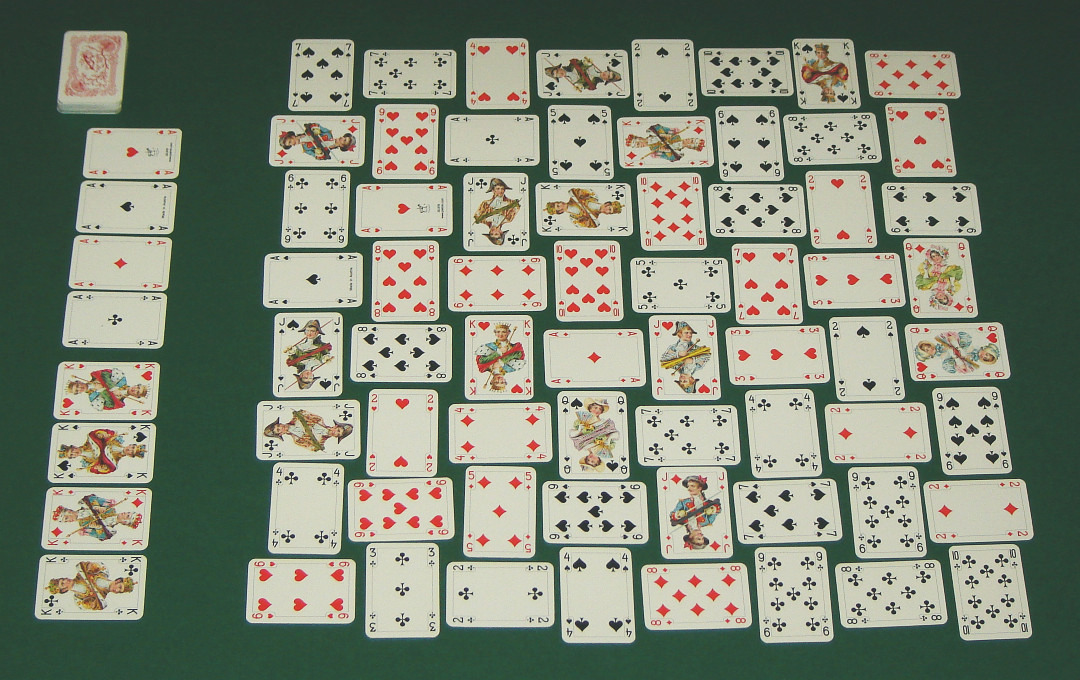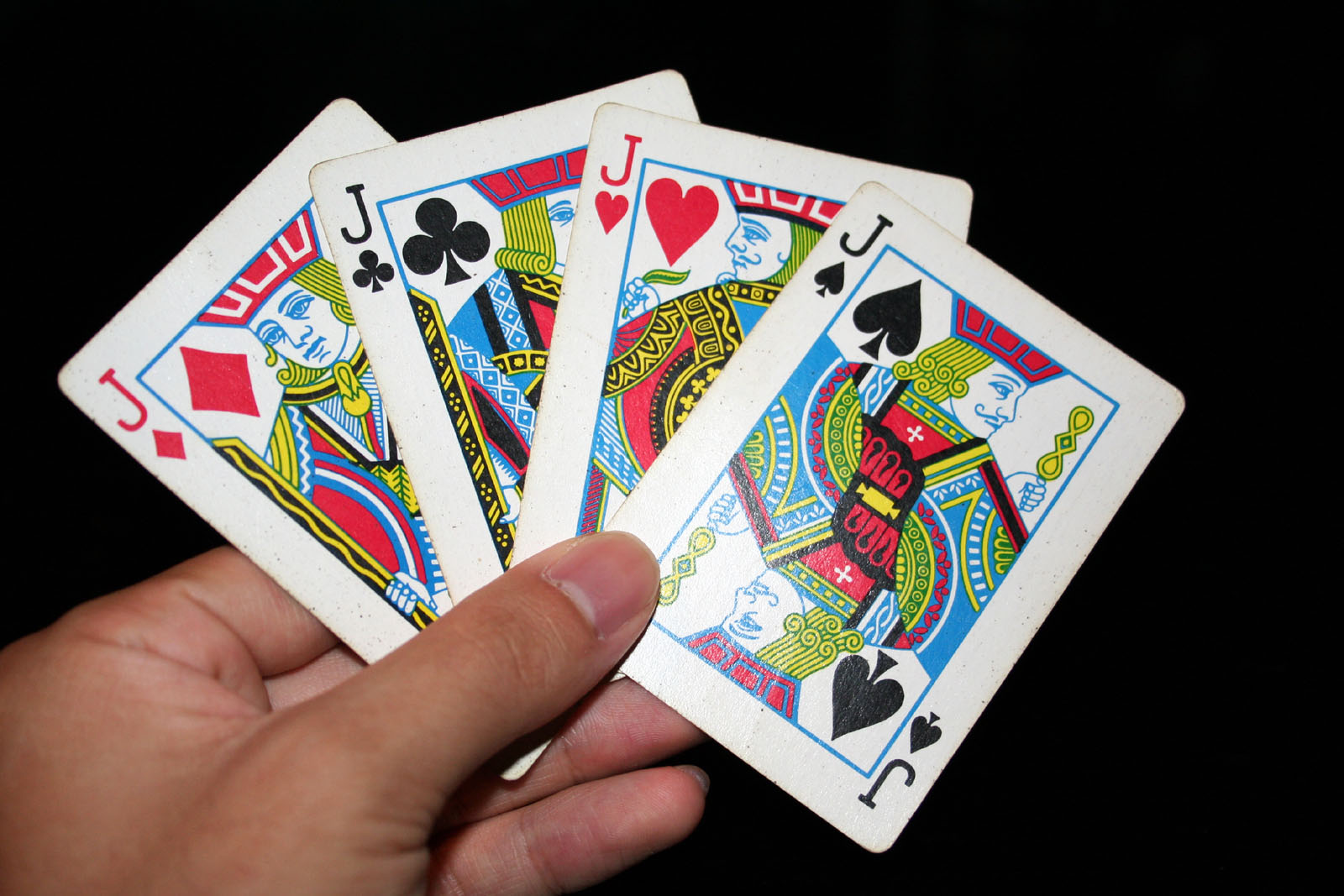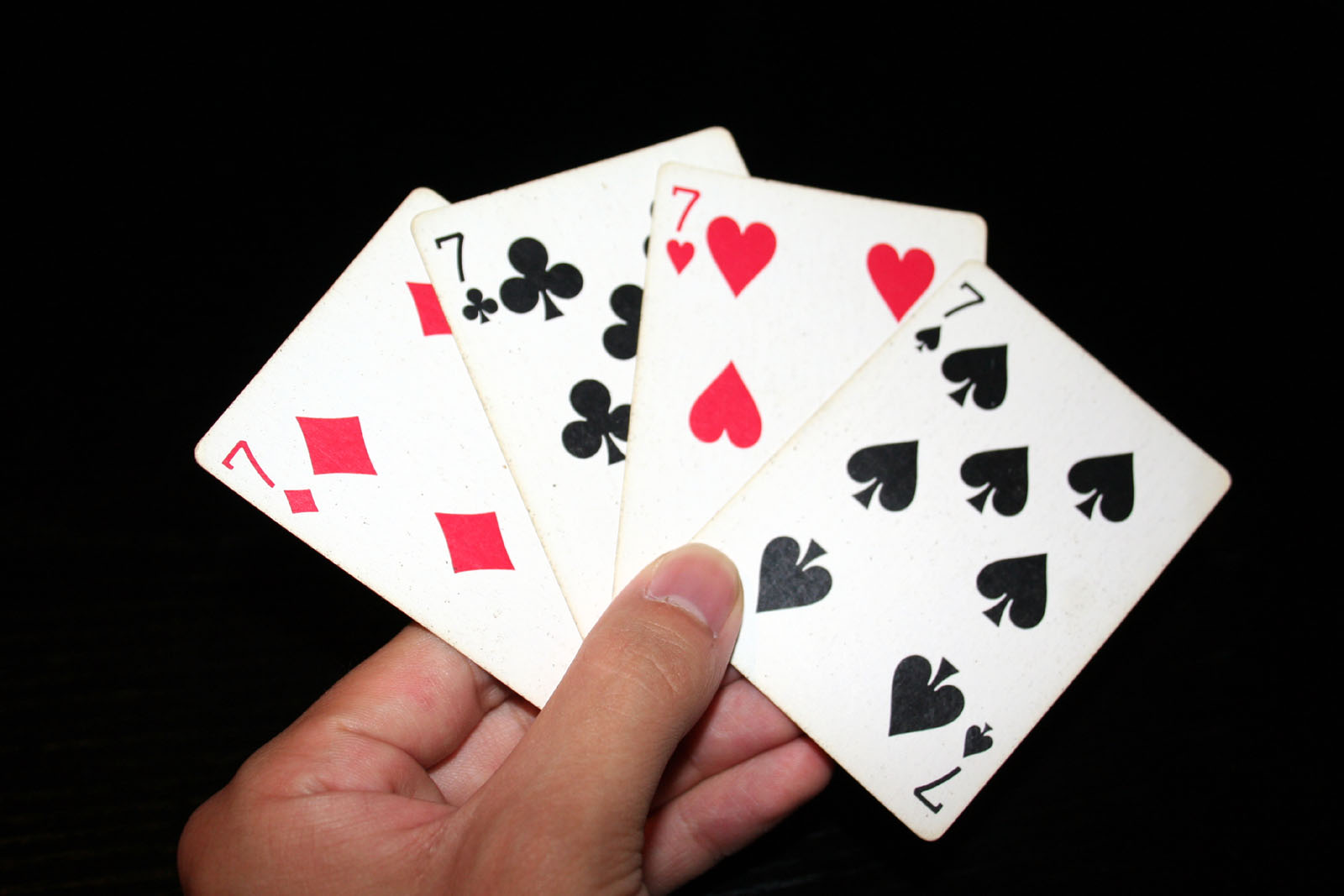|
Elevens
Elevens is a patience or card solitaire of the Simple Addition family that uses a standard 52-card deck, with the goal of removing pairs of cards that add to eleven.Moyse (1950), p. 5. Odds of winning are slightly better than 1 in 10. Rules Cards are placed in a 3x3 grid. Pairs of cards which add up to eleven (5 and 6; 4 and 7; 3 and 8; 2 and 9; Ace and 10) are covered up. Face cards ( J, Q, K) may be eliminated in a set of three cards consisting of one Jack, one Queen and one King regardless of suit. If all cards are covered up the game is won; if there are no more pairs of cards that add up to eleven, and there do not exist a Jack, a Queen, and a King, the game is lost. Strategy An individual game of Elevens is a game of pure chance, except for the small element of skill involved in spotting the pairs; the skill and strategic interest comes in not shuffling the cards at the end of each game, but instead collecting them up in order. Variations Elevens is very similar to sev ... [...More Info...] [...Related Items...] OR: [Wikipedia] [Google] [Baidu] |
List Of Solitaires
This is a list of patiences, which are card games that are also referred to as solitaires or as card solitaire. This list is not intended to be exhaustive, but only includes games that have met the usual Wikipedia requirements (e.g. notability). Additions should only be made if there is an existing entry on Wikipedia that they can be linked to. To avoid duplicate pages being created, alternative titles and the names of variants are listed separately (except titles that include little more than the name of the parent game). Games of the patience genre played by more than one player are marked with a plus (+) sign. A * Accordion * Aces and Kings * Aces Square * Aces Up * Acme * Addiction * Agnes * Alaska * Algerian * Alhambra * Amazons * American Toad * Apophis * Appreciate * Acquaintance * Archway * Auld Lang Syne * Australian Patience B * Babette * Backbone * Baker's Dozen * Baker's Game * Baroness * Batsford * Beetle * Beleaguered Castle * Belvedere * ... [...More Info...] [...Related Items...] OR: [Wikipedia] [Google] [Baidu] |
Simple Addition
Simple Addition or Totals is a family of patience (game), patience or card solitaire games that share certain aims and procedures.Moyse (1950), p. 5.Parlett (1979), pp. 177–179. Composition Moyse counts the games of Elevens, Fifteens, Tens and Thirteens as part of the Simple Addition family. Parlett adds Baroness (card game), Baroness, Block Eleven and Block Ten, Decade (solitaire), Decade, Haden, Nines, Seven Up or Seventh Wonder, Pyramid (solitaire), Pyramid or Pile of Twenty-Eight, Fourteens and Eighteens or Ferris Wheel, Grand Round or Wheel. Simple Addition sometimes also refers specifically to the game of Thirteens.Dick (1898), p. 19. References Bibliography * Dick, Harris B. (1898). ''Dick's games of patience; or, Solitaire with cards.'' 2nd Series. 113 pp. 70 games. NY: Dick & Fitzgerald. * Moyse, Alphonse Jr. (1950). ''150 Ways to Play Solitaire''. USPCC. 128 pp. * Parlett, David (1979). ''The Penguin Book of Patience'', London: Penguin. {{card-game-stub S ... [...More Info...] [...Related Items...] OR: [Wikipedia] [Google] [Baidu] |
Patience (game)
Patience (Europe), card solitaire or solitaire (US/Canada), is a genre of card games whose common feature is that the aim is to arrange the cards in some systematic order or, in a few cases, to pair them off in order to discard them. Most are intended for play by a single player, but there are also "excellent games of patience for two or more players". Name 'Patience' is the earliest recorded name for this type of card game in both British and American sources. The word is French in origin, these games being "regarded as an exercise in patience." Although the name solitaire became common in North America for this type of game during the 20th century, British games scholar David Parlett notes that there are good reasons for preferring the name 'patience'. Firstly, a patience is a card game, whereas a solitaire is any one-player game, including those played with dominoes or peg and board games. Secondly, any game of patience may be played competitively by two or more players. Am ... [...More Info...] [...Related Items...] OR: [Wikipedia] [Google] [Baidu] |
Card Solitaire
Patience (Europe), card solitaire or solitaire (US/Canada), is a genre of card games whose common feature is that the aim is to arrange the cards in some systematic order or, in a few cases, to pair them off in order to discard them. Most are intended for play by a single player, but there are also "excellent games of patience for two or more players". Name 'Patience' is the earliest recorded name for this type of card game in both British and American sources. The word is French in origin, these games being "regarded as an exercise in patience." Although the name solitaire became common in North America for this type of game during the 20th century, British games scholar David Parlett notes that there are good reasons for preferring the name 'patience'. Firstly, a patience is a card game, whereas a solitaire is any one-player game, including those played with dominoes or peg and board games. Secondly, any game of patience may be played competitively by two or more players. Am ... [...More Info...] [...Related Items...] OR: [Wikipedia] [Google] [Baidu] |
Standard 52-card Deck
The standard 52-card deck of French-suited playing cards is the most common pack of playing cards used today. In English-speaking countries it is the only traditional pack used for playing cards; in many countries of the world, however, it is used alongside other traditional, often older, standard packs with different suit systems such as those with German-, Italian-, Spanish- or Swiss suits. The most common pattern of French-suited cards worldwide and the only one commonly available in Britain and the United States is the English pattern pack. The second most common is the Belgian-Genoese pattern, designed in France, but whose use spread to Spain, Italy, the Ottoman Empire, the Balkans and much of North Africa and the Middle East.''Pattern Sheet 80'' at i-p-c-s.org. Retrieved 23 August 2020. In addition to those, there are other major in ... [...More Info...] [...Related Items...] OR: [Wikipedia] [Google] [Baidu] |
Face Cards
In a deck of playing cards, the term face card (US) or court card (British and US), and sometimes Royalty, is generally used to describe a card that depicts a person as opposed to the pip cards. They are also known as picture cards, or until the early 20th century, coat cards. History While playing cards were invented in China, Chinese playing cards do not have a concept of face cards. When playing cards arrived in Iran, the Persians created the first face cards.The best preserved deck is located in the Topkapı Palace. To avoid idolatry, the cards did not depict human faces and instead featured abstract designs or calligraphy for the ''malik'' (king), ''nā'ib malik'' (viceroy or deputy king) and ''thānī nā'ib'' (second or under-deputy). It is possible that the Topkapı deck, a custom made luxury item used for display, does not represent the cards played by commoners. There are fragments of what may be Mamluk court cards from cheaper decks showing human figures which may expla ... [...More Info...] [...Related Items...] OR: [Wikipedia] [Google] [Baidu] |
Jack (playing Card)
A Jack or Knave, in some games referred to as a bower, is a playing card which, in traditional French and English decks, pictures a man in the traditional or historic aristocratic or courtier dress, generally associated with Europe of the 16th or 17th century. The usual rank of a jack is between the ten and the queen. History The earliest predecessor of the knave was the (second or under-deputy) in the Mamluk card deck. This was the lowest of the three court cards and like all court cards was depicted through abstract art or calligraphy. When brought over to Italy and Spain, the was made into an infantry soldier or page ranking below the knight card. In France, where the card was called the valet, the queen was inserted between the king and knight. The knight was subsequently dropped out of non-Tarot decks leaving the valet directly under the queen. The king-queen-valet format then made its way into England. As early as the mid-16th century the card was known in England a ... [...More Info...] [...Related Items...] OR: [Wikipedia] [Google] [Baidu] |
Queen (playing Card)
The queen is a playing card with a picture of a queen on it. In many European languages, the king and queen begin with the same letter so the latter is often called ''dame'' (lady) or variations thereof. In French playing cards, the usual rank of a queen is between the king and the jack. In tarot decks, it outranks the knight which in turn outranks the jack. In the Spanish deck and some Italian decks, the Queen does not exist and the Knight appears in them instead, with the same role and value. In several card games, including the middle eastern Trex and French Barbu, the queen is a major card to avoid taking, with each queen taken inflicting a penalty on the player. Similarly, in Hearts, the queen of spades is to be avoided, and is called a variety of unsavoury names. In the Paris pattern, each court card is identified as a particular historical or mythological personage as follows: Cultural references Regarding the anonymous nursery rhyme, " The Queen of Hearts" (publis ... [...More Info...] [...Related Items...] OR: [Wikipedia] [Google] [Baidu] |
King (cards)
The king is a playing card with a picture of a king displayed on it. The king is usually the highest-ranking face card. In the French version of playing cards and tarot decks, the king immediately outranks the queen. In Italian and Spanish playing cards, the king immediately outranks the knight. In German and Swiss playing cards, the king immediately outranks the '' Ober''. In some games, the king is the highest-ranked card; in others, the ace is higher. Aces began outranking kings around 1500 with Trappola being the earliest known game in which the aces were highest in all four suits. In the Ace-Ten family of games such as pinochle and schnapsen, both the ace and the 10 rank higher than the king. History The king card is the oldest and most universal court card. It most likely originated in Persian Ganjifeh where kings are depicted as seated on thrones and outranking the viceroy cards which are mounted on horses. Playing cards were transmitted to Italy and Spain via the Mam ... [...More Info...] [...Related Items...] OR: [Wikipedia] [Google] [Baidu] |
Suit (cards)
In playing cards, a suit is one of the categories into which the cards of a deck are divided. Most often, each card bears one of several pips (symbols) showing to which suit it belongs; the suit may alternatively or additionally be indicated by the color printed on the card. The rank for each card is determined by the number of pips on it, except on face cards. Ranking indicates which cards within a suit are better, higher or more valuable than others, whereas there is no order between the suits unless defined in the rules of a specific card game. In a single deck, there is exactly one card of any given rank in any given suit. A deck may include special cards that belong to no suit, often called jokers. History Modern Western playing cards are generally divided into two or three general suit-systems. The older Latin suits are subdivided into the Italian and Spanish suit-systems. The younger Germanic suits are subdivided into the German and Swiss suit-systems. The French suits a ... [...More Info...] [...Related Items...] OR: [Wikipedia] [Google] [Baidu] |
Good Thirteen
Good Thirteen (german: Die gute Dreizehn) is a simple, German patience game for one person, played using a French pack of 52 playing cards. It also goes under the name Thirteens. Rules A standard French deck of 52 playing cards is shuffled and placed face down as a stock on the table. The top ten cards are dealt face-up in a row on the table as the starting layout. Pairs of cards adding up to 13 points, regardless of their suit are removed and placed to one side. The card values of the pip cards correspond to their face value. In addition, the Ace scores one, the Jack eleven, the Queen twelve and the King thirteen. Individual Kings, which are the only cards with a value of 13, may be removed on their own. The resulting gaps are filled with new cards from the stock. * Example: ''In the following layout the single King and the pairs 8+5, 10+3 and Jack (11)+2 can be removed.'' The game ends when the stock is exhausted. If all the cards have been removed, the patience has be ... [...More Info...] [...Related Items...] OR: [Wikipedia] [Google] [Baidu] |
Glossary Of Solitaire
Games of patience, or (card) solitaires as they are usually called in North America, have their own 'language' of specialised terms such as "building down", "packing", "foundations", "talon" and "tableau". Once learnt they are helpful in describing, succinctly and accurately, how the games are played. Patience games are usually for a single player, although a small number have been designed for two and, in rare cases, three or even four players. They are games of skill or chance or a combination of the two. There are three classes of patience grouped by object. The most frequent object is to arrange the cards either in ascending sequence (e.g. from Ace to King) or descending sequence. Occasionally both forms of sequence are aimed at in the same game. The card forming the starting point of the required sequence is known as the foundation card and the sequence or family is said to be 'built up' on such card. In some cases foundation cards are picked out and placed in position ... [...More Info...] [...Related Items...] OR: [Wikipedia] [Google] [Baidu] |








